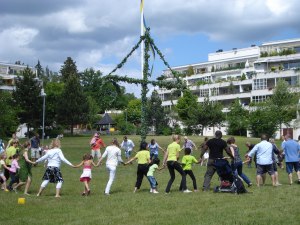Howdy, y’all! (Please humor my temporary lapse into Kansan colloquialism.) I’m back in the Sunflower State once again!
The trip from Sweden to Chicago was pleasant enough. I was seated next to an American college student who was on his way home from visiting his mother’s family in Finland (his relatives are Swedish-speaking). Within three minutes we were engaged in a (friendly) debate about the nature of “globalization” and the fate of the world. Later, the conversation drifted into subjects related to our personal adventures in globe trotting and our views on life in the Nordic countries. He was enamored with Swedish women and nightlife in Helsinki, and had no qualms about explaining his experience with both in detail.
Mentally, I contrasted this flight companion with the one that I had on my way to Stockholm last fall. I arrived at my seat and found a middle aged Swedish gentleman occupying the space next to me. After an initial, “hej”, he said no other word to me or even looked in my direction until breakfast the following morning. After he had eaten and the plane was about 30 minutes from the airport, he began flapping his jaws about how much better I would enjoy Sweden over the U.S., even though it would be difficult for me to find a decent steak in Stockholm. Quiet and anti-American… I would meet many more of his type in the coming months.
Back to my most recent travels. By the time my next flight, which was from Chicago to Kansas City, left the airport in Illinois, it was already due to land in Missouri. The reason for the delay, of course, was the weather. Storms had put the the aircraft and its crew behind on schedule on the preceding trip from Minnesota. Once we were finally in the air, turbulence kept the flight attendant from serving us our beverages. Dadgumit. We were put into a holding pattern outside of Kansas City, as heavy rain, high wind, and reports of hail prevented our touchdown. After circling for about three quarters of an hour, we were diverted to the airport in Omaha, Nebraska, as our fuel was running low and there was little hope of the storm abating soon.
After we landed, it was hinted by United Airlines staff that we would be put on a bus to complete the trip to KC by road. What would have taken 20 minutes by air would have taken 3.5 hours by ground. Obviously, it was not a happy development for me and my travel mates. Luckily, the eventual solution was to wait for a flight team to arrive in Omaha from Denver. After a few invigorating (-insert sarcastic tone here-) hours in the Omaha Airport, the new team flew us from Nebraska to Kansas City. I finally met my sister a little after 1:00 in the morning (poor girl had been waiting at the airport for hours).
It was a lovely feeling to cross the river into Kansas, a place I had left nearly 11 months before. Home! Like Dorothy, I can tell you that indeed, “there is no place like home!”


